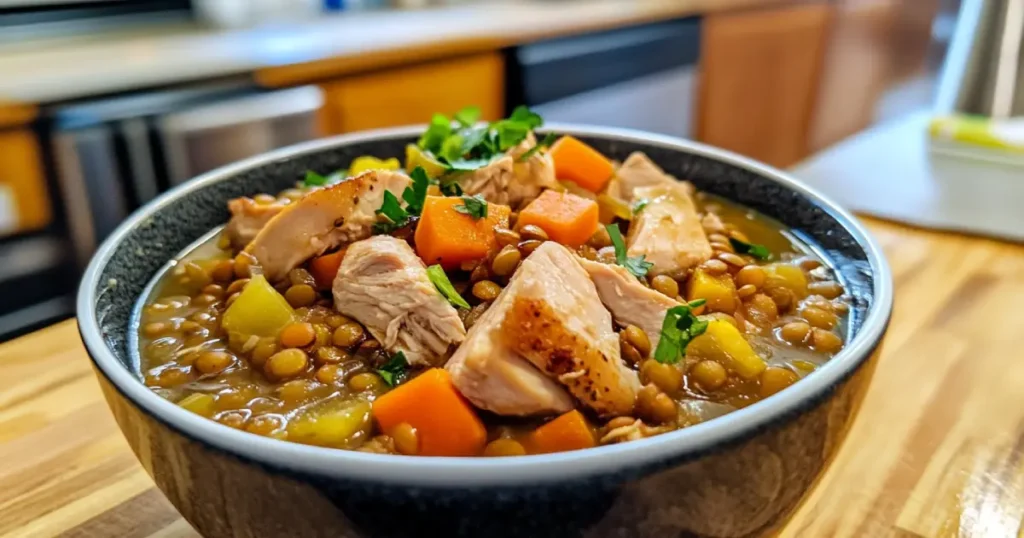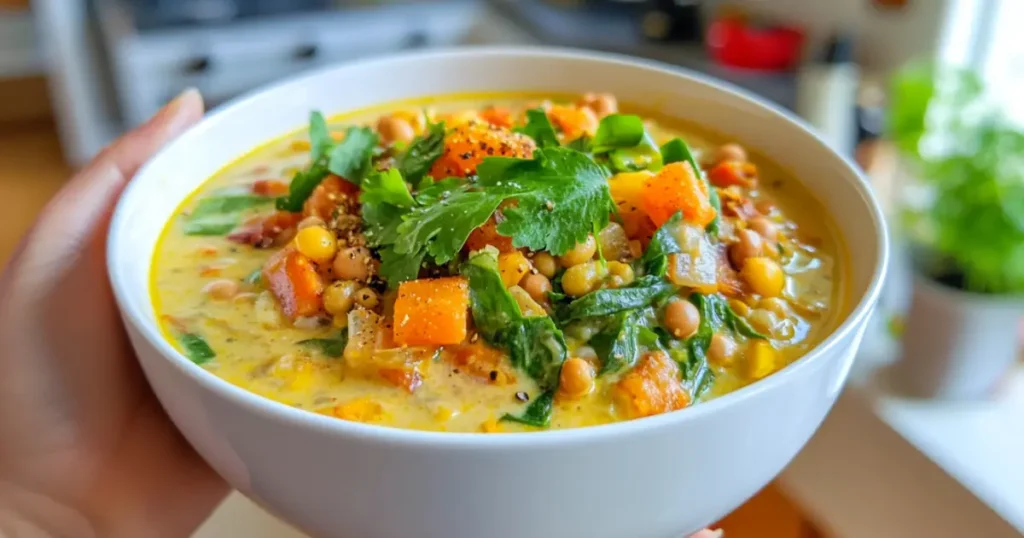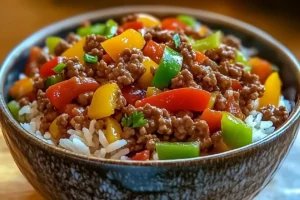Soup season is here, and there’s nothing like a warm, hearty bowl of soup to satisfy your hunger and nourish your body. But did you know soups can be more than just comfort food? Packed with lean proteins, fiber-rich vegetables, and nutrient-dense grains, high protein soup recipes are a delicious way to fuel your day. In this article, we’ll explore a variety of protein-packed soups, share tips for creating your own, and dive into storage hacks that make these meals perfect for meal prep. Let’s get started with the why and how of high-protein soups!
Outline
The Importance of High Protein Soups in a Healthy Diet
Why High Protein Meals Are Essential for Wellness
Protein is the building block of life—literally. It helps repair tissues, supports muscle growth, and keeps your immune system strong. Including high protein foods in your diet isn’t just for athletes; it’s a must for anyone looking to feel full and energized throughout the day. Soups, when crafted thoughtfully, can deliver a powerhouse of protein alongside vitamins and minerals.
High protein soups stand out because they’re easy to digest, making them ideal for post-workout recovery or when you’re under the weather. Plus, they’re versatile enough to cater to various dietary needs—vegan, gluten-free, or low-carb!
How Soups Can Be a Protein-Packed Option
You might think of soup as a light starter, but with the right ingredients, it can be a protein-rich main dish. By combining legumes, lean meats, grains, or plant-based proteins, you can create a meal that not only satisfies but also keeps you full for hours. Adding ingredients like quinoa, lentils, or chicken breast can boost the protein content without overwhelming the dish.
The best part? Soups allow you to get creative! Whether it’s a Mexican black bean soup or a creamy spinach and tofu broth, there’s a recipe to match your taste buds and dietary preferences.
Nutritional Benefits of Ingredients Used in High Protein Soups
High protein soup recipes often feature nutrient-dense ingredients like:
- Legumes (lentils, chickpeas, black beans): High in protein and fiber, legumes promote satiety and support gut health.
- Lean meats (chicken, turkey, seafood): These provide complete proteins, meaning they contain all the essential amino acids your body needs.
- Vegetables (spinach, kale, carrots): Loaded with vitamins and antioxidants, they elevate the nutritional profile of your soup.
- Grains (barley, quinoa): These are not only protein-packed but also add texture and heartiness.
By using these ingredients, you can create soups that are both satisfying and nutritionally balanced. Better yet, these soups are cost-effective and perfect for batch cooking!
Essential Ingredients for High Protein Soup Recipes
1. Protein-Rich Legumes and Grains
- Why They’re Important:
Legumes and grains are nutrient powerhouses, adding protein, fiber, and heartiness to soups.- Example: Lentils contain up to 18 grams of protein per cup, making them ideal for filling meals.
- Grains like quinoa (a complete protein) and barley (known for its chewy texture) make soups satisfying and nutrient-dense.
- How to Use Them:
- Add lentils, chickpeas, or quinoa for a protein boost.
- Try them in recipes like Tuscan white bean soup or barley vegetable soup.
- They’re budget-friendly and perfect for meal prep.
2. Lean Meat Options for Soups
- Why They’re Important:
Meats like chicken, turkey, and seafood are rich in protein and ideal for high-protein soups.- Example: Chicken breast provides about 31 grams of protein per 100 grams.
- How to Use Them:
- Use chicken in classics like chicken noodle soup for a nourishing option.
- Choose lighter proteins like turkey or fish (e.g., salmon or cod) for brothy soups or creamy chowders.
- Add lean ground beef to a vegetable beef barley soup or seafood to a spicy gumbo.
3. Plant-Based Protein Additions (Tofu, Tempeh, and More)
- Why They’re Important:
Plant-based proteins like tofu, tempeh, and edamame offer substantial protein, perfect for vegetarian or vegan soups.- Tofu’s neutral flavor makes it versatile for both spicy and mild broths.
- Tempeh’s nutty taste complements hearty soups like Thai coconut curry soup.
- How to Use Them:
- Incorporate edamame, tofu, or tempeh into soups for a protein boost.
- Sprinkle chia seeds or crushed almonds for added texture and protein.
- Shine in recipes like creamy spinach soups or spicy black bean broths.
4. Broth Basics: The Foundation of a Flavorful Soup
- Why It’s Important:
A great broth is the cornerstone of every flavorful soup.- Opt for low-sodium stocks (chicken, beef, seafood, or vegetable) to balance flavors and maintain health benefits.
- How to Use It:
- For added protein, use bone broth (rich in collagen and amino acids).
- Make homemade broths with aromatics like garlic, onions, and herbs for maximum flavor and nutrients.
Top 5 High Protein Soup Recipes
Hearty Chicken and Lentil Soup

Ingredients
- 2 tablespoons olive oil
- 1 medium onion, finely chopped
- 2 medium carrots, diced
- 2 celery stalks, diced
- 3 garlic cloves, minced
- 1 teaspoon ground cumin
- 1 teaspoon smoked paprika
- 1/2 teaspoon turmeric
- 1/2 teaspoon dried thyme
- 1 cup dried lentils (green or brown), rinsed
- 2 cups cooked chicken, shredded or cubed
- 6 cups chicken broth
- 1 can (14 oz) diced tomatoes
- 1 bay leaf
- Salt and black pepper to taste
- Fresh parsley or cilantro for garnish (optional)
Instructions
Prepare the Base
- Heat olive oil in a large pot over medium heat.
- Add the chopped onion, diced carrots, and diced celery. Sauté for 5–7 minutes, until the vegetables soften.
Add Aromatics
- Stir in minced garlic, ground cumin, smoked paprika, turmeric, and dried thyme. Cook for 1–2 minutes until fragrant.
Add Lentils and Liquid
- Add the rinsed lentils, chicken broth, diced tomatoes, and bay leaf to the pot. Stir to combine.
Simmer the Soup
- Bring the mixture to a boil, then reduce the heat to low. Cover and simmer for 25–30 minutes, or until the lentils are tender.
Add Chicken
- Stir in the cooked chicken. Simmer for an additional 10 minutes to allow the flavors to meld together.
Season and Serve
- Scoop the soup into bowls and top with fresh parsley or cilantro, if you like.
- Remove the bay leaf. Season the soup with salt and black pepper to taste.
Creamy Spinach and Tofu Soup
This vegan-friendly option is rich, creamy, and satisfying. Silken tofu blends seamlessly into the broth, creating a velvety texture that pairs beautifully with wilted spinach. For added flavor, incorporate garlic and a splash of coconut milk. This soup is proof that plant-based eating can be both nutritious and indulgent.
Mexican-Inspired Black Bean and Quinoa Soup
Looking for something spicy and hearty? This high protein soup recipe combines black beans, quinoa, and vibrant spices like cumin and chili powder. Top it off with avocado slices or a dollop of Greek yogurt for a zesty finish. With over 25 grams of protein per serving, it’s a one-pot wonder that doesn’t skimp on flavor.
Tuscan White Bean Soup with Kale

This Mediterranean-inspired soup is as wholesome as it is delicious. Cannellini beans and kale provide a double dose of protein and fiber, while olive oil and Italian herbs elevate the flavor. Serve it alongside crusty bread for a satisfying meal.
Vegetable Beef Barley Soup
For a true comfort food experience, try this hearty soup loaded with lean beef, barley, and a medley of vegetables. The barley adds a chewy texture that complements the tender beef, creating a protein-rich dish that’s perfect for cold nights.
Additional Recipes to Explore
- No-Bean Chili: A unique twist on a classic dish, featuring ground turkey and diced tomatoes for a meaty, high-protein option.
- Seafood Chowder: Packed with shrimp, scallops, and creamy broth, this chowder is perfect for seafood lovers.
- Oxtail Soup: A slow-cooked delight rich in protein and collagen, great for a hearty meal.
- Instant Pot Protein Soups: Quick, customizable options for busy weeknights.
Tips for Creating Your Own High Protein Soup Recipes
Building the Perfect Protein Base
Creating a great high protein soup recipe starts with the foundation: the protein. Start by selecting a high-quality protein source such as chicken, turkey, lentils, or tofu. These options work well with most soup styles, whether you’re making a hearty stew or a light broth-based dish.
For an even greater protein boost, try layering multiple sources. For instance, pairing chicken with quinoa or lentils ensures a richer nutrient profile while enhancing the texture of your soup.
Balancing Macronutrients for Flavor and Nutrition
When crafting your soup, aim for a balance between protein, healthy fats, and carbs. For example, adding olive oil and root vegetables like sweet potatoes provides a satisfying balance of nutrients. Including high-fiber ingredients like beans or leafy greens also makes the soup more filling, ideal for anyone seeking a complete meal in one bowl.
Remember to adjust seasoning as you go. Protein-rich ingredients tend to absorb spices, so taste and tweak frequently to get that perfect flavor profile.
Using Herbs and Spices for Depth and Variety
Herbs and spices are the secret weapon in making high protein soup recipes both flavorful and unique. Fresh herbs like parsley, thyme, and cilantro add a burst of freshness, while spices like cumin, turmeric, and smoked paprika deepen the flavor. Experiment with different combinations to complement your protein choice—curry powder for lentil soups or rosemary for chicken-based broths, for example.
If you’re looking for more meal ideas, check out Leftover Rotisserie Chicken Recipes for inspiration on how to repurpose ingredients creatively.
Storing, Reheating, and Meal Prepping High Protein Soups
Best Practices for Freezing and Reheating Soups
High protein soups are fantastic for meal prep, but proper storage is key to maintaining their quality. Once your soup cools, store it in airtight containers to keep it fresh. Soups with grains like barley or quinoa can thicken when frozen, so you might want to add extra broth when reheating.
When it’s time to reheat, use low to medium heat to preserve the texture and flavor. Stir frequently, and add a splash of water or stock if the soup becomes too thick.
Storage Solutions for Maximum Freshness
Investing in high-quality containers ensures your soup stays fresh longer. Glass containers are ideal for freezing and reheating, while BPA-free plastic containers work well for shorter storage times. Label your containers with the date to keep track of freshness, especially when you’re freezing large batches.
Portioning for Easy Meal Prep
Portioning your soups before storing them makes meal prep easier. Use single-serve containers to create grab-and-go meals. This method is perfect for busy weekdays when you want a high protein soup recipe ready to heat and enjoy.
For more delicious ideas to complement your meal plan, visit What to Do with Leftover Rotisserie Chicken.
FAQs
What Can I Add to Soup for More Protein?
If you want to boost the protein content of your soup, consider adding:
Cooked meats: Chicken, turkey, lean beef, or pork can significantly increase protein.
Plant-based options: Tofu, tempeh, lentils, or chickpeas are excellent for vegetarian soups.
Grains: Quinoa, farro, or barley not only provide protein but also make the soup heartier.
Dairy products: Greek yogurt, cottage cheese, or a sprinkle of shredded cheese can add creaminess and protein.
Eggs: Stir in a whisked egg for an egg drop soup effect, or top with a poached egg.
Bone broth: Swap regular stock for bone broth, which is rich in collagen and protein.
What Is the Healthiest Soup You Can Eat?
The healthiest soups are those packed with nutrient-dense ingredients. A few top contenders include:
Vegetable lentil soup: High in protein, fiber, and vitamins while being low in calories.
Chicken and kale soup: Combines lean protein with antioxidant-rich greens.
Miso soup with tofu: A light, probiotic-rich option great for digestion.
Tomato and quinoa soup: Loaded with lycopene, protein, and whole grains. The healthiest soups avoid heavy creams, excessive sodium, and processed ingredients while emphasizing fresh vegetables, lean proteins, and healthy fats.
Can You Build Muscle Eating Soup?
Yes, you can absolutely build muscle eating soup, provided it contains the right nutrients. Soups with lean proteins like chicken, turkey, fish, or plant-based proteins like lentils and beans are excellent for muscle growth. Pairing them with healthy carbs (like quinoa or barley) and fats (like olive oil or avocado) provides a complete macronutrient profile to support muscle repair and growth.
To maximize the muscle-building potential of soup, consider adding additional protein sources, such as a boiled egg or shredded chicken, and eating it as part of a balanced diet with adequate calories and protein intake.
In Closing
High protein soup recipes are more than just comforting meals; they’re a versatile and nutritious way to fuel your body. From classic chicken and lentil soups to creative plant-based options like creamy spinach and tofu, these recipes cater to a variety of tastes and dietary needs. Packed with protein, fiber, and essential nutrients, they make meal prep simple and satisfying.
By incorporating lean proteins, hearty legumes, and vibrant vegetables, you can craft soups that not only taste great but also support your health goals. Whether you’re looking to manage your weight, build muscle, or simply enjoy a wholesome meal, there’s a high protein soup recipe for everyone.
So grab your favorite ingredients, get creative with herbs and spices, and start experimenting with these delicious recipes. Your next bowl of soup might just become your go-to meal for comfort, nutrition, and convenience!




Recipes didn’t come up